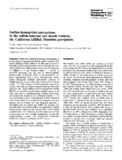Sulfide-hemoglobin interactions in the sulfide-tolerant salt marsh resident, the California killifish Fundulus parvipinnis

Associated URL
swfsc.noaa.govNgày
1992Page views
445metadata
Hiển thị bản ghi đầy đủ mặt hàngCited times in Scopus
- Citations
- CrossRef - Citation Indexes: 24
- Policy Citation - Policy Citations: 1
- Scopus - Citation Indexes: 28
- Captures
- Mendeley - Readers: 26
Share
trừu tượng
Sulfide can potentially damage hemoglobin or be detoxified by hemoglobin. In the sulfide-tolerant California killifish neither seems to be the case at environmentally realistic (micromolar) and physiologically relevant (millimolar) sulfide concentrations. An 8-h exposure of killifish to 5 and 8 mmol sulfide · 1 -1 results in 50–100% mortality, but not due to sulfhemoglobin (where sulfide covalently binds to the porphyrin) nor ferric hemoglobin (Hb + ), both dysfunctional hemoglobin derivatives. Killifish hemoglobin converts to sulfhemoglobin in vitro only in the presence of 1–5 mmol sulfide · 1 -1 . The amount of sulfhemoglobin formed increases with time and heme concentration but decreases with pH. Hb + binds sulfide as ferric hemoglobin sulfide (Hb + S, an unstable complex where sulfide ligates to the iron), and also as sulfhemoglobin. Killifish blood does not catalyze the oxidation of 10–500 µmol sulfide · 1 -1 to any appreciable extent. Radiolabeled sulfide incubated with oxyhemoglobin or whole blood disappears at rates greater than in buffers, but only minimal amounts of thiosulfate and no sulfate nor sulfite are formed (elemental sulfur and bound sulfide not quantified). Sulfide disappearance rates increase linearly with initial sulfide concentration. Hb + does catalyze the oxidation of sulfide to thiosulfate in vitro. Similar experiments on another sulfide-tolerant species, the long-jawed mudsucker Gillichthys mirabilis , produced similar results.
Suggested Citation
Bagarinao, T., & Vetter, R. D. (1992). Sulfide-hemoglobin interactions in the sulfide-tolerant salt marsh resident, the California killifish Fundulus parvipinnis. Journal of Comparative Physiology B: Biochemical, Systemic, and Environmental Physiology , 162(7), 614-624. https://doi.org/10.1007/BF00296642
Chủ thể
Taxonomic term
Bộ sưu tập
- AQD Journal Articles [1248]

